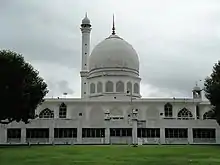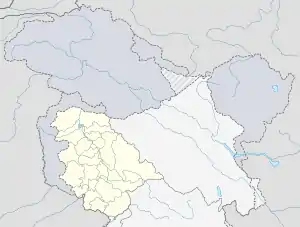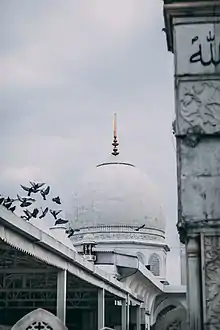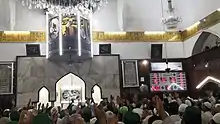Hazratbal Shrine
The Hazratbal Shrine (lit. "Majestic Place") is a Muslim shrine in Hazratbal, Srinagar, Jammu and Kashmir, India. It contains a relic, the Moi-e-Muqqadas, which is believed to be Prophet Muhammad's hair.[1] The name of the shrine comes from the Farsi word Hazrat, meaning "respected", and the Kashmiri word bal, meaning "place". Thus it means the place which is given high regards and is respected among the people.
| Dargah Sharief | |
|---|---|
درگاہ شریف | |
 | |
| Religion | |
| Affiliation | Islam |
| District | Srinagar |
| Region | Kashmir Valley |
| Leadership | Jammu & Kashmir Muslim Waqf Board |
| Status | active |
| Location | |
| Location | Hazratbal, Srinagar |
| Municipality | Srinagar |
| State | Jammu and Kashmir |
| Country | India |
 Shown within Jammu and Kashmir  Hazratbal Shrine (India) | |
| Geographic coordinates | 34°7′45″N 74°50′32″E |
| Architecture | |
| Type | Islamic architecture |
| Style | Classical |
| Specifications | |
| Length | 105 metres (344 ft) |
| Width | 25 metres (82 ft) |
| Dome(s) | 1 |
| Minaret(s) | 1 |
| Website | |
| http://www.wakf.gov.in/jammukashmir/ | |
The shrine is situated on the Northern bank of the Dal Lake, Srinagar, and is considered to be Kashmir's holiest Muslim shrine.[2]
History and present status

The mosque contains strands of Muhammad's hair, often referred to as "the relic of Hazratbal shrine" or simply, "the relic". The relic was first brought to Kashmir by Syed Abdullah, a purported descendant of Muhammad who left Medina and settled in Bijapur, near Hyderabad in 1635.
When Syed Abdullah died, his son Syed Hamid inherited the relic. Following the Mughal conquest of the region, Syed Hamid was stripped of his family estates. Finding himself unable to care for the relic, he sold it to a wealthy Kashmiri businessman Khwaja Nur-ud-Din Eshai.
However, when the Mughal Emperor Aurangzeb came to know of what had transpired, he had the relic seized and sent to the shrine of Khwaja Moinuddin Chishti at Ajmer, and had Khwaja Nur-ud-Din Eshai imprisoned in Delhi for possessing the relic. Later, realizing his mistake, Aurangzeb decided to restore the relic to Khwaja Nur-ud-Din Eshai and to allow him to take it to Kashmir. However, Khwaja Nur-ud-Din Eshai had already died in imprisonment. In 1700, the relic finally reached Kashmir, along with the body of Khwaja Nur-ud-Din Eshai. There, Inayat Begum, daughter of Khwaja Nur-ud-Din Eshai, became a custodian of the relic and established the shrine. Since then, her male descendants have been caretakers of the relic.[3]

Her male descendants belong to what is known as the Banday family. Currently (as of 2019), 3 main members care for the holy relic: Dr. Manzoor Ahmad Banday, Ishaq Banday and Mohiuddin Banday. The Holy Relic is displayed for public viewing only on special occasions like the birthday of Prophet Muhammad and his 4 main companions, Hazrat Abu Bakr Siddique, Hazrat Umar ibn Khattab, Hazrat Usman ibn Affan and Hazrat Ali.
The caretakers of the shrine are known as Nishandehs. The eldest male heirs of the previous Nishandeh continues the legacy of displaying the relic when the current Nishandeh passes away.

Hazratbal relic disappearance episode
The relic was reported to have disappeared on 27 December 1963. There were mass protests all over the state on the disappearance of the Moi-e-Muqaddas (the Hair of the Prophet) with hundreds of thousands out in the streets. The Awami Action Committee was formed to recover the relic. On 31 December, Indian Prime Minister Jawaharlal Nehru made a broadcast to the nation on the disappearance of the sacred relic.
The relic was recovered on 4 January 1964.[3][4]
This incident then sparked huge communal tensions and escalation of violence in East Pakistan and there were heavy influx of 2 Lakh refugees to India as a result of that.[5]
See also
| Wikimedia Commons has media related to Hazratbal shrine. |
References
- "Moslems Riot Over Theft of Sacred Relic", Chicago Tribune, 29 December 1963, p1
- "Kashmir Yield at Shrine". New York Times. 7 August 1994. The shrine is known by many names including Hazratbal, Assar-e-Sharief, Madinat-us-Sani, or simply Dargah Sharif.
- Hari Narain Verma; Amrit Verma (1998). Decisive battles of India through the ages, Volume II. GIP Books. p. 124. ISBN 978-1-881155-04-1. Retrieved 22 June 2010.
- Neelam Francesca; Rashmi Srivastava (2008). Secularism in the postcolonial Indian novel: national and cosmopolitan narratives in English. Volume 17 of Routledge research in postcolonial literatures. Routledge. p. 70. ISBN 978-0-415-40295-8. Retrieved 22 June 2010.
- Das, Mayurakshi. "Title: Calcutta Cauldron: City-life during the January 1964 Riots". Indian History Congress Proceedings.